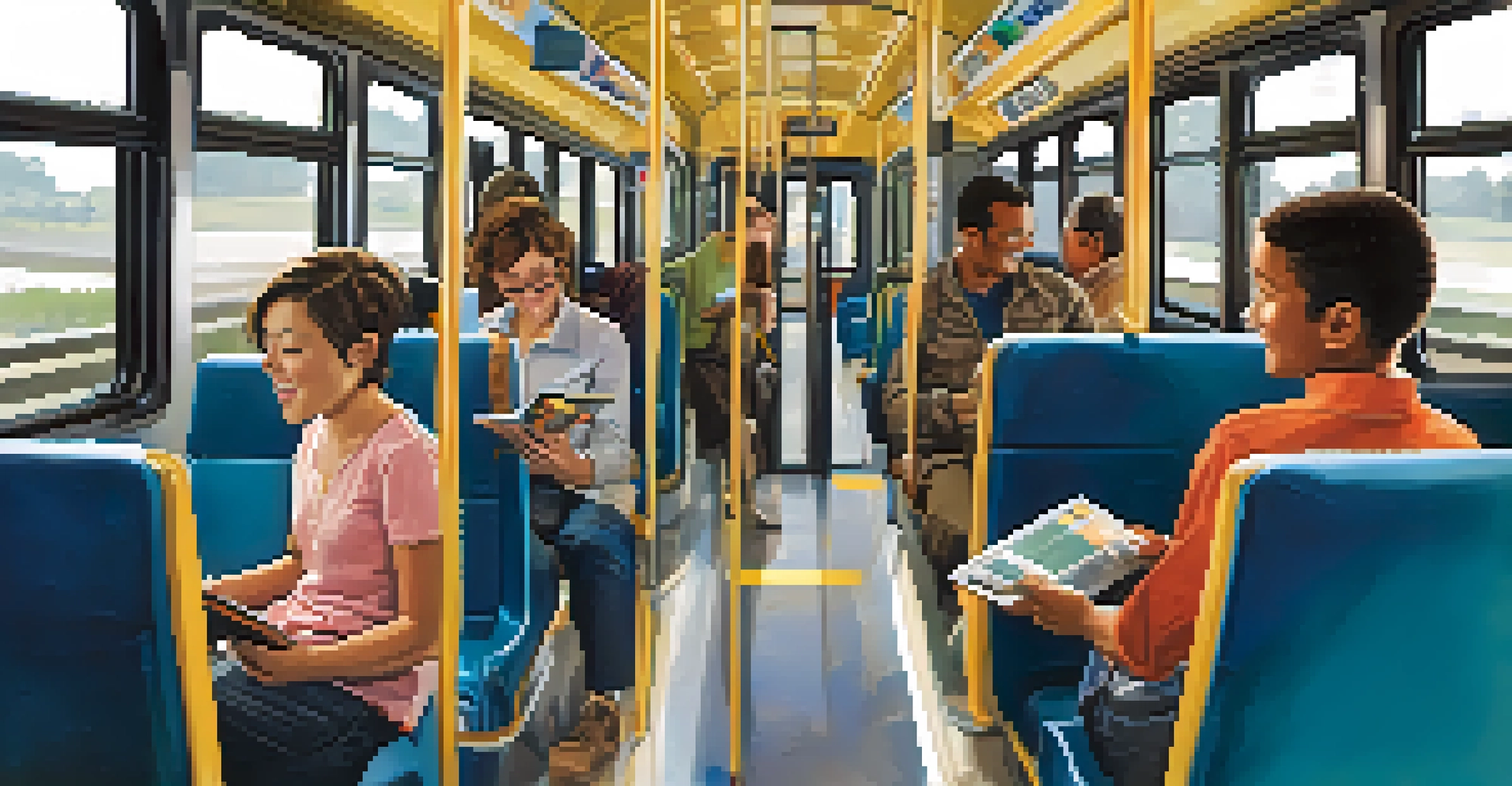Public Transportation in Illinois: Systems and Challenges

Overview of Public Transportation in Illinois
Public transportation in Illinois plays a crucial role in connecting communities and facilitating mobility. From bustling Chicago to smaller towns, various systems cater to the diverse needs of residents. In this state, public transit includes buses, trains, and ferries, each serving as vital lifelines for daily commuters and travelers alike.
Public transportation is a lifeline for those who cannot afford a car, and it should be a priority for every community to ensure equitable access to these services.
The Chicago Transit Authority (CTA) leads the way, offering extensive bus and rail services throughout the city. Meanwhile, regional systems like Metra and Pace extend connectivity to suburban areas, highlighting the importance of a cohesive transportation network. This intricate web of services aims to reduce traffic congestion and promote sustainable travel alternatives.
Despite its robust framework, public transportation in Illinois faces ongoing challenges. Issues such as funding gaps and maintenance concerns threaten the reliability and expansion of these services, necessitating a closer examination of potential solutions.
The Role of Chicago Transit Authority (CTA)
The Chicago Transit Authority (CTA) is the backbone of public transportation in the city, operating both the 'L' train system and numerous bus routes. With millions of rides taken each year, the CTA aims to provide efficient and affordable transit options to residents and visitors. Its extensive network not only supports daily commuting but also fosters tourism, making Chicago accessible to everyone.

The CTA continually works on enhancements, from modernizing train stations to introducing real-time tracking apps. These improvements aim to increase convenience and user satisfaction, making public transit a viable option for many. However, the challenge remains to maintain these services amidst budget constraints and rising operational costs.
CTA: Chicago's Transit Backbone
The Chicago Transit Authority (CTA) provides essential bus and rail services that support both daily commuting and tourism in the city.
Additionally, the CTA faces the task of addressing equity in transit access. Ensuring that underserved neighborhoods receive adequate service is vital for fostering inclusivity and promoting equal opportunities for all residents.
Metra: Connecting Suburban Regions
Metra serves as the commuter rail system for the greater Chicago area, providing essential connections between the city and its suburbs. With over 11 lines, it accommodates thousands of commuters daily, offering a reliable alternative to driving. Metra's service is particularly crucial for those who work in the city but live in outlying areas.
Sustainable public transportation is not just an option; it is a responsibility we have to our communities and the planet.
The charm of riding Metra lies in its scenic routes that showcase the beauty of Illinois. While many commuters appreciate the comfort of train travel, Metra faces challenges such as punctuality issues and aging infrastructure that require urgent attention. Addressing these matters is vital for maintaining rider trust and satisfaction.
Moreover, Metra is working on enhancing its services to attract younger passengers. By integrating modern technology and improving station amenities, Metra aims to create a more appealing experience for the next generation of commuters.
Pace Suburban Bus: Serving the Outskirts
Pace is the suburban bus service that complements the CTA and Metra by providing essential transit options in less densely populated areas. With a focus on flexibility and accessibility, Pace operates numerous routes that connect residents to key destinations, including shopping centers and transit hubs. This service is especially beneficial for those who may not have access to a personal vehicle.
In recent years, Pace has introduced innovations like on-demand services, allowing riders to book a ride through a mobile app. This adaptability is crucial in a rapidly changing transportation landscape, catering to the diverse needs of suburban populations. However, the challenge remains in effectively marketing these services to ensure they reach potential users.
Funding Issues Plague Public Transit
Illinois public transportation faces significant funding challenges, impacting service reliability and accessibility for low-income riders.
Pace also plays a vital role in promoting environmental sustainability by encouraging public transit usage over personal vehicle reliance. As more residents recognize the ecological benefits of public transportation, Pace strives to expand its reach and improve service efficiency.
Funding Challenges for Public Transit
One of the most pressing issues facing public transportation in Illinois is the struggle for adequate funding. State and local governments often face budget constraints, which can lead to service cuts and fare increases that disproportionately affect low-income riders. This creates a cycle where those who rely on public transit the most are the ones who bear the brunt of funding shortfalls.
In recent years, various initiatives have been proposed to address these funding challenges, including increased state investment and public-private partnerships. However, securing sustainable funding remains a contentious issue, requiring ongoing advocacy and collaboration among stakeholders. Finding a balance between maintaining existing services and expanding transit options is essential for future growth.
Moreover, the effects of the COVID-19 pandemic further complicated funding efforts, as ridership levels dropped significantly. As transit agencies work to recover, creative solutions and community support will be vital in restoring public confidence in public transportation.
Equity and Access in Illinois Transit Systems
Equity in public transportation is a critical issue in Illinois, as not all communities receive the same level of service. Low-income neighborhoods and communities of color often face transportation deserts, where access to reliable transit is limited. This inequity can hinder job opportunities, access to education, and overall quality of life for residents.
To address these disparities, transit agencies must prioritize inclusivity in their planning and service delivery. Engaging with community members to understand their needs can lead to more responsive transit solutions. Programs aimed at improving service in underserved areas are crucial for fostering equitable access to public transportation.
Equity in Transit Access is Crucial
Addressing disparities in public transportation service is vital for ensuring equitable access to opportunities for underserved communities in Illinois.
Additionally, partnerships with local organizations can enhance outreach efforts, ensuring that information about services reaches those who need it most. By working together, transit agencies and communities can create a more equitable transportation system that benefits everyone.
Sustainability Initiatives in Public Transportation
As concerns about climate change grow, public transportation systems in Illinois are increasingly adopting sustainability initiatives. These efforts include transitioning to electric buses, investing in energy-efficient infrastructure, and promoting the use of public transit to reduce carbon emissions. Such initiatives not only contribute to environmental conservation but also enhance public health by improving air quality.
Agencies like the CTA are exploring innovative technologies, such as solar power and battery storage, to reduce their carbon footprint. By prioritizing sustainability, public transit systems not only appeal to environmentally conscious riders but also align with broader state and national goals for reducing greenhouse gas emissions.

Furthermore, educating the public about the environmental benefits of using public transportation can encourage more people to leave their cars at home. As awareness grows, the demand for sustainable transit options will likely increase, prompting further investments in eco-friendly initiatives.